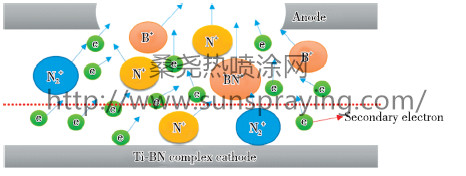Generally, a type of bonded solid lubricating coating is composed of binder, solid lubricant and filler. As the film-forming material, the binder determines the processing technology and basic physical-chemical performances of the lubricating coating. According to the types of binder, the bonded solid lubricating coatings can be mainly divided into three categories: organic, inorganic and organic-inorganic hybrid coatings. The organic coating has good flexibility and processability but low strength, and the inorganic coating has good hardness but too brittle nature. Organic-inorganic hybrid coatings has proved to be effective in improving comprehensive properties due to it combines the unique advantages both of the organic polymer and inorganic component compared to neat organic or inorganic no-hybrid coatings. In general, many routes such as mechanical blending method, intercalation method, sol-gel method, self-assembly method and the like, have been used for preparing organic-inorganic hybrid coatings. Especially, the in situ sol-gel process is always considered as a popular method to obtain high performance organic-inorganic hybrid coatings. During this process, the inorganic networks structure originating from inorganic precursor are formed and covalently bonded to the organic polymer networks by bridging effect of coupling agent. Therefore, interpenetrating polymer networks (IPNs) including two cross-linked structures can be finally established. For the hybrid bonded solid lubricating coatings, the addition of this inorganic network greatly promotes the mechanical performance of the binder. Actually, the inorganic network can also be considered as reinforcing filler that improves the wear resistance of the lubricating coating. As one of the most efficient curing technologies commercially available today, the ultravoilet radiation curing technique (UV curing) has been devoted much attention in extensive applications during the past decades, which mainly attributes to its high efficiency and low energy consumption compared to thermally curing. UV curing ultimately forms the three-dimensional (3D) interpenetrating polymer network structures and provides the coating with more excellent performance. It also can be operated at ambient temperature. Unfortunately, there are few reported works available to the preparation and tribological properties of the UV curing hybrid bonded solid lubricating coatings. Here a novel organic-inorganic hybrid bonded solid lubricating coating with excellent tribological properties was prepared by an efficient and low-cost method of ultraviolet radiation technique. The nano-indentation and scratch tests were conducted to evaluate the mechanical properties of the hybrid coating with different inorganic content. In addition, the effects of polytetrafluoroethylene (PTFE) content and test conditions on tribological behaviors of the hybrid lubricating coatings were investigated. The experimental results show that the indentation hardness and elastic modulus of the hybrid coatings were improved synchronously by increasing the inorganic content in the binder formulations, and the hybrid coating containing 10 wt. % inorganic components presented better scratch resistance than others. Moreover, the best tribological properties were obtained when the mass ratio of PTFE to binder was 0.4. And the hybrid lubricating coating showed good resistance to the variation of sliding speed (frequency) and was susceptible to the load applied in present work.

本文由桑尧热喷涂网收集整理。本站文章未经允许不得转载;如欲转载请注明出处,北京桑尧科技开发有限公司网址:http://www.sunspraying.com/
|

